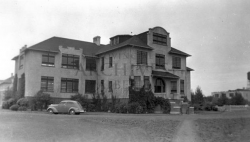Alberta Hospital Edmonton
| Alberta Hospital Edmonton | |
|---|---|
 | |
| Established | 1920 |
| Opened | 1923 |
| Current Status | Active |
| Building Style | Cottage Plan |
| Location | Edmonton, AB |
| Alternate Names |
|
History[edit]
In the spring of 1923, with crowding becoming a deeper problem at the Hospital for the Insane in Ponoka, it was decided to make the facility a mental hospital for adults. It was to become a home for, in the parlance of the time, the chronically insane. Its first patients were 47 First World War veterans, transferred from the Hospital for Returned Soldiers in Red Deer.
While the original facility contained several buildings, today just Building No. 1 survives. This three-story brick and stucco structure ranks as one of the few remaining buildings of its type in the province. Its cruciform 2,200 square metre layout with crenelated roof line, front bay windows and arched oak vestibule with terrazzo flooring shows influences of the English Jacobethan Revival Style. The style is characterized by its multi-paned windows, shaped parapet, hipped roof and bay windows. Early on, the basement contained a dining room and school room, there was a day room on the main floor, dormitory rooms and the main and second floors and staff bedrooms in the attic. There were 15 staff in those days, overseen by Dr. David Dick, the facility's medical superintendent.
In her history of the institution, writer Sheila Abercrombie notes that Dick was a military doctor who had served in the First World War and had headed two military hospitals. Dicks organization and operation of the institute was exceedingly military in style, with a strict hierarchy of authority, rigid rules and routines, tight schedules, and a Spartan environment.
Starting in those early years of operations, patients raised much of their food through farm work. In fact, gardening was considered as the best therapy — a belief that many relaxed gardeners of healthy mind will also attest. Patients growing their own food was phased out in 1962.
In 1971, patient dormitory spaces were eliminated and the original building converted to occupational therapy rooms. Ten years later, a major restoration was launched and the second floor became classrooms and offices for the Highwood School. By the late 1980s, the hospital was the largest psychiatric centre in the province, maintaining 650 active treatment beds for the mentally ill. Now known as Alberta Hospital Edmonton, the facility at 17480 Fort Road has grown to 45 buildings spread over 275 acres.
There have been other changes, too. In 1923 the cost per patient was calculated at 86 cents per day. Now it tops $300 a day. Mind you, back in the 1920s, there was no such thing as active treatment. Before the days of tranquillizers, staff really didn't work much at helping patients to heal. The hospital was a custodial facility, where well-sedated "incurable" mental patients spent their lives doing farm chores. The science of caring for the mentally ill has come a long way.[1]

